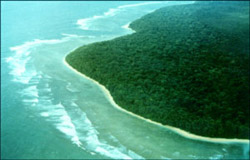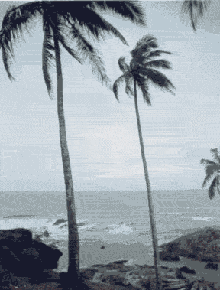| Destinations
|
|||||||||||||||
The origin of the indigenous population of the Andaman and Nicobar Islands is shrouded in mystery. It is believed that Negrito communities may have migrated here from the east and north when the islands were connected to Burma, or the sea was sufficiently shallow to allow transport by canoe. Their survival has been under constant threat ever since Western traders and colonizers introduced disease, indulged in widespread deforestation and brought about rapid cultural disintegration of the population. It is estimated that of the 5000 aborigines in 1858 less than 700 inhabitants remained by 1950 in both the Great and Little Andaman groups. Divided into 12 or 13 'tribes' or tribal units on the basis of linguistic and cultural differences, the Andaman Islanders are clustered into two major groups; a 10-tribe group in the Great Andamnas and 2 or 3 tribes in the Little Andamans. |
More on Andamans • Overview • Geography • History • Economy • Climate • Port Blair
Travelogues
|
||||||||||||||
On the Nicobar Islands, the Mongoloid Nicobarese claiming descent from a Burmese prince have integrated with recent settlers and while they continue to live in small communities of grass huts raised on stilts, have adopted modern agricultural methods, raising pigs rather than hunting. Less than 200 of the still unaccustomed Shompen of Great Nicobar live on the coast and barter in honey, cane and nuts with the Nicobarese in isolated pockets further inland.
The Jarawas who were originally located on the present site of Port Blair, now live on the western coasts of Middle and South Andaman, hemmed in by the Andaman Trunk Road, which since the 1970s has cut them off from hunting grounds and fresh water supplies. Nevertheless, possessive about their land, they remain unwilling to mix and contact with settlers is limited to gift-exchange at each full moon, a time of celebration. The Onges were once used by the Chinese and Japanese to dive for valuable shells in exchange for alcohol and opium. Today the largest tribe on the Andaman Islands they live on Little Andaman and Rutland Island in communal shelters (bera) and construct temporary thatched huts (korale). Unlike other tribes, the Onges do not practice tattooing, but they paint their bodies with white clay and ochre, and the women smear themselves with yellow dye from orchids.
Local groups, or bands, consisted of about 20-50 members; each group associated with a traditional resource territory, throughout which it moved during the year. Local groups could usually obtain permission to forage in neighboring territories. There were no tribal chiefs and leadership on the local level was based on respect for the advice of older and more talented members of the community. Disputes were amicably settled by interested parties.
Daily ritual dances central to communal life were held on land enclosed by huts. Intergroup contacts were generally peaceful; their dwellers getting together at times of abundance. The present day settlers comprise people of all faiths - Hindus, Muslims, Christians, Sikhs who speak languages like Hindi, Bengali, Malayalam, Tamil, Telugu, Punjabi. They live together in complete harmony. Inter-religion and inter-regional marriages are common. The amazing racial and cultural mix correctly describes the Andamans as mini India. Compiled by Puneet Sachdeva
|
|||||||||||||||
Editor: Romola Butalia (c) India Travelogue. All rights reserved. |
|||||||||||||||

 The Andaman Islanders were foragers, subsisting on whatever
they could hunt, fish, or collect. The Andaman communities,
divided into eramtaga (jungle-dwellers), and ar-yuato (coast
dwellers) subsist on fish, turtles, turtle eggs, pigs, fruits,
honey and roots. Bows and arrows were used for both hunting
and fishing. Harpoon fishing and hunting with dogs appear to
have been later introductions. Reef collection was done with
nets. Males were primarily hunters and fishers but also
engaged in secondary collection activities. Females were
primarily collectors of vegetable products, reef fauna and
small animals. The Andaman Islanders' animal foods included
pig, civet cat, lizards, rats, snakes, insects, birds,
turtles, fish, mollusks and crustaceans. The bulk of their
diet, however, came from fruits, roots, seeds and other plant
products. Seasonal feasts of wild honey are also noted in
literature.
The Andaman Islanders were foragers, subsisting on whatever
they could hunt, fish, or collect. The Andaman communities,
divided into eramtaga (jungle-dwellers), and ar-yuato (coast
dwellers) subsist on fish, turtles, turtle eggs, pigs, fruits,
honey and roots. Bows and arrows were used for both hunting
and fishing. Harpoon fishing and hunting with dogs appear to
have been later introductions. Reef collection was done with
nets. Males were primarily hunters and fishers but also
engaged in secondary collection activities. Females were
primarily collectors of vegetable products, reef fauna and
small animals. The Andaman Islanders' animal foods included
pig, civet cat, lizards, rats, snakes, insects, birds,
turtles, fish, mollusks and crustaceans. The bulk of their
diet, however, came from fruits, roots, seeds and other plant
products. Seasonal feasts of wild honey are also noted in
literature.
 The typical household seems to have been the monogamous
nuclear family. Partners were frequently found in other groups
or tribes and post marital residence patterns were flexible.
Divorce was rare, especially after the birth of the first
child. Adoption was a common feature of Andaman society. Both
males and females underwent puberty rites. Shamans were
thought to have special powers for curing, sorcery and dream
interpretation and was achievable by either males or females,
but such achievement depended on the acceptance by the group
of the individual's claim to special powers. The cosmology of
the Andaman Islanders contained a variety of animistic spirits
and spirits of the dead.
The typical household seems to have been the monogamous
nuclear family. Partners were frequently found in other groups
or tribes and post marital residence patterns were flexible.
Divorce was rare, especially after the birth of the first
child. Adoption was a common feature of Andaman society. Both
males and females underwent puberty rites. Shamans were
thought to have special powers for curing, sorcery and dream
interpretation and was achievable by either males or females,
but such achievement depended on the acceptance by the group
of the individual's claim to special powers. The cosmology of
the Andaman Islanders contained a variety of animistic spirits
and spirits of the dead.